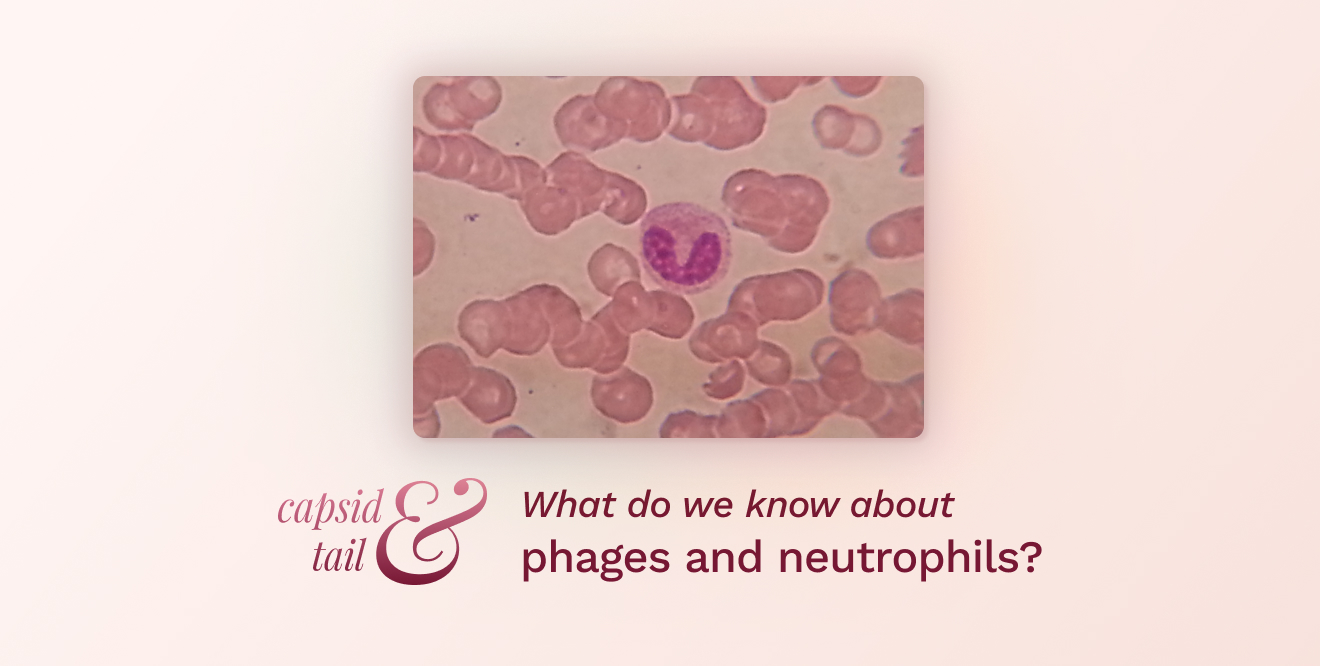Last week as I was writing about Echterhof et al. (about how their new preprint showed that neutrophils aren’t the culprit when it comes to phage lifespan in serum), I started thinking back to another phage+neutrophil paper I remember reading. This was a few years back; but I seemed to remember neutrophils being important/essential for phage therapy to work. It made me want to check back to that paper and see how these two phage-neutrophil papers might fit together.
As I was looking for that paper I came across an even newer one about the same topic by the same main author, Dwayne Roach (who now runs a lab at SDSU). Interesting — what did this new one find? And how does that fit with the others?
What is going on with phages and neutrophils?
What are neutrophils again?
But first! What are neutrophils again? None of us have taken immunology since undergrad, right?
- White blood cells (they are the most abundant kind, making up 55-70% of most adults’ white blood cells!)
- First-line responders meant for quickly fighting/neutralizing infection (bacteria and fungi mostly)
- Phagocytes — they engulf microbes and release factors (like reactive oxygen species and NETs) that kill them
- Unlike macrophages, they only last for hours/days (not months/years), and they don’t really present antigens to T cells like macrophages do.
So neutrophils are the short-lived, quick-acting, more simplistic first responders of the white blood cells. And they’re super prevalent!
A quick look at 3 ~recent phage-neutrophil papers
Now back to phages, and what we know about how they see and interact with neutrophils. First, a brief look at the three papers I mentioned (I am sure there are more; this is not exhaustive!) and what they found:
Roach et al. (2017) demonstrated that neutrophils play a crucial role in the success of phage therapy against a Pseudomonas aeruginosa lung infection in mice.
- They used PAK_P1, a Myovirus
- They infected mice with P. aeruginosa and administered phages intranasally
- They had neutropenic and normal mice (neutropenia was induced by administering anti-granulocyte receptor-1 (Gr1) monoclonal antibody) (neutrophils are granulocytes)
- They saw the neutropenic mice were ‘completely unresponsive’ to phage treatment
- They did a lot of mathematical modeling to build a predictive model of when phage therapy would work, and what matters (and tested a bunch of other immunodeficiencies other than neutropenia, that I haven’t gone into here)
- They concluded that synergy between phages and neutrophils leads to resolution of bacterial infection
Roach et al. (2023) investigated the direct effects of P. aeruginosa phage PAK_P1 on isolated human neutrophils in vitro.
- They used PAK_P1, a Myovirus
- They isolated neutrophils; incubated directly with several concentrations of phage
- Phage did not significantly affect other neutrophil functions such as apoptosis, oxidative burst, or NET formation.
- The highest concentration of phages (a cell:phage ratio of 1:10,000) they tested triggered a small increase in IL-8 production
- Phage exposure did not alter neutrophil responses to other inflammatory stimuli
- Of note, the phages were not actively replicating in this experiment (host was not present since that would have impacted the neutrophils)
Echterhof et al. (2024) focused on the role of neutrophils in the clearance and pharmacokinetics of intravenously administered phages in uninfected mice.
- They used LPS-5, a Podovirus
- They depleted neutrophils by dosing mice with cyclophosphamide and administered phages intravenously
- They found that neutrophil depletion had minimal impact on phage half-life in blood and spleen, suggesting that neutrophils do not significantly contribute to phage clearance in the absence of infection.
Summary
So taken together, what do we know about phage-neutrophil interactions?
- In the absence of infection, neutrophils don’t clear phage LPS-5 from circulation.
- During an active infection, neutrophils work synergistically with phage PAK_P1 to clear P. aeruginosa. Or in other words, without neutrophils, this phage didn’t work therapeutically.
- PAK_P1 phage by itself does not strongly activate or modulate neutrophil functions in vitro.
So neutrophils are friends (of phages), not foes?
Based on these three papers, this is my rough hand-wavey conclusion.
If generally true, this could be construed as good news from a safety perspective (it’s nice if phages don’t freak out the innate immune system and make patients sicker). That said, sometimes the immune system is helpful, and we don’t always want it to be silent. Fortunately when bacteria are present, the immune system does tend to kick in, and it seems like can really help a phage do its job.
Other things that would be cool to explore
It will be interesting to find out if this generally neutral-to-positive neutrophil relationship is true for more phages than the ones tested to date. Are neutrophils always going to pretty much either ignore or help phages? Or are some phages harder to ignore? Or harder to help?
And of course, it will be interesting to find out more about what aspects of the immune system do perk up when they see a phage (since many have shown that something is clearing phages from circulation), and what those responses look like.
Reach out if you’re working on something in this area! I would love to chat, and dive into one of your papers in a future post (or you can write one!!).
References
Roach, D. R., Leung, C. Y., Henry, M., Morello, E., Singh, D., Di Santo, J. P., Weitz, J. S., & Debarbieux, L. (2017). Synergy between the host immune system and bacteriophage is essential for successful phage therapy against an acute respiratory pathogen. Cell Host & Microbe, 22(1), 38-47.e4. https://doi.org/10.1016/j.chom.2017.06.018
Roach, D. R., Noël, B., Chollet-Martin, S., de Jode, M., Granger, V., Debarbieux, L., & de Chaisemartin, L. (2023). Human neutrophil response to Pseudomonas bacteriophage PAK_P1, a therapeutic candidate. Viruses, 15(8), 1726. https://doi.org/10.3390/v15081726
Echterhof, A., Dharmaraj, T., McBride, R., Berry, J., Hopkins, M., Selvakumar, H., Miesel, L., Chia, J.-H., Lin, K.-Y., Shen, C.-C., Lee, Y.-L., Yeh, Y.-C., Liao, W. T., Suh, G., Blankenberg, F. G., Frymoyer, A. R., & Bollyky, P. L. (2024). The contribution of neutrophils to bacteriophage clearance and pharmacokinetics in vivo. bioRxiv. https://doi.org/10.1101/2024.01.25.577154








